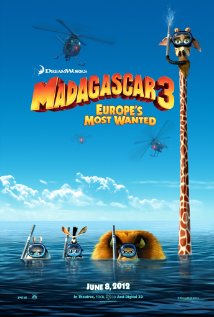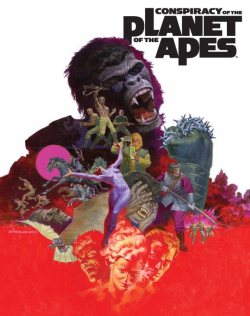chimpanzees
Video: Coldplay's "Adventure of a Lifetime"
Posted by Fred on Sun 29 Nov 2015 - 13:27This music video, for the band Coldplay's "Adventure of a Lifetime", may be of some interest.
It was filmed at the Imaginarium, the digital motion capture studio set up by Andy Serkis and Jonathan Cavendish in London. Is this the first of many realistic anthropomorphic mo-cap music videos that we can see in the future?
Review: 'Further: Beyond the Threshold', by Chris Roberson
Posted by Fred on Sun 24 Jun 2012 - 19:35 The first line in this science-fiction novel is: “When I woke up, surrounded by talking dog-people, it was clear we’d strayed pretty far from the mission parameters.” (p. v) There are a talking chimpanzee in a smoking jacket, cravat, and pin-striped trousers; a gigantic lion with a hairless human head; and a robot in the form of a silvery-mercury metallic eagle in the first scene. Furry, no. Anthropomorphic science-fiction, yes.
The first line in this science-fiction novel is: “When I woke up, surrounded by talking dog-people, it was clear we’d strayed pretty far from the mission parameters.” (p. v) There are a talking chimpanzee in a smoking jacket, cravat, and pin-striped trousers; a gigantic lion with a hairless human head; and a robot in the form of a silvery-mercury metallic eagle in the first scene. Furry, no. Anthropomorphic science-fiction, yes.
Captain Ramachandra Jason Stone is a 22nd century spaceman, the captain of Wayfarer One, the first interstellar spaceship launched to travel to Alpha Centauri. The crew is put into cryogenic suspension for the forty-three year voyage, but something goes wrong.
The Wayfarer One is not found and Stone revived until 12,000 years later. By then, humanity – defined as anything sentient, whether a natural life-form or an Artificial Intelligence – has spread into the Human Entelechy, a “superculture of thousands of inhabited worlds and habitats linked by the threshold network, centered roughly on Sol. There are roughly ten trillion sentients, not counting the large number of intelligences who exist as digital incarnations in virtual domains”, etc. (p. 45)
47North, May 2012, trade paperback $14.95 (vi + 343 [+ 1] pgs.), Kindle $4.99, audiobook $10.
Review: ‘Madagascar 3: Europe’s Most Wanted’ is Furry Jesus
Posted by crossaffliction on Tue 12 Jun 2012 - 00:13 I was in a bad mood all day when I went to see this movie. A real bad mood.
I was in a bad mood all day when I went to see this movie. A real bad mood.
I was looking forward to seeing it, however, because I decided it would cheer me up. I wasn't expecting it to be great and cheer me up; I expected it to be bad, and then I would get to take out all my frustrations on it in my review.
Essentially, if this movie was not the second coming of Furry Jesus, I was going to rip it a new orifice which I would then proceed to assuage my rage.
Can I even write that?
Anyway, you read the headline; this movie cheered me right up in the way I did not expect it to. By not sucking. Also, by not only not sucking, but by really not sucking a lot.
Review: 'Conspiracy of the Planet of the Apes', by Andrew E. C. Gaska.
Posted by Fred on Thu 22 Mar 2012 - 05:06 2011’s Planet of the Apes movie, Rise of the Planet of the Apes, is unusual in that it has no novelized tie-in. Instead, the movie release’s tie-in book is Conspiracy of the Planet of the Apes, an almost-coffee-table hardcover novel featuring an original “offstage” story by Andrew Gaska (from a plot by Gaska, Rich Handley, Christian Berntsen, and Erik Matthews) set during the events of the 1968 movie, imaginatively depicted by “over 50 illustrations from various top talents in the industry, including full-color paintings by Jim Steranko, Joe Jusko, Dave Dorman, Barron Storey, Sanjulian and Mark Texeira, starship design by Andrew Probert, character portraits by Matt Busch and more!” (publisher’s catalogue).
2011’s Planet of the Apes movie, Rise of the Planet of the Apes, is unusual in that it has no novelized tie-in. Instead, the movie release’s tie-in book is Conspiracy of the Planet of the Apes, an almost-coffee-table hardcover novel featuring an original “offstage” story by Andrew Gaska (from a plot by Gaska, Rich Handley, Christian Berntsen, and Erik Matthews) set during the events of the 1968 movie, imaginatively depicted by “over 50 illustrations from various top talents in the industry, including full-color paintings by Jim Steranko, Joe Jusko, Dave Dorman, Barron Storey, Sanjulian and Mark Texeira, starship design by Andrew Probert, character portraits by Matt Busch and more!” (publisher’s catalogue).
In the 1968 movie, four astronauts are sent in frozen hibernation on a 2,006-year mission to explore an extrasolar planet. One dies en route; the other three, Taylor, Landon, and Dodge, find a planet inhabited by intelligent apes and feral humans. The astronauts are separated, and the story follows Col. George Taylor (Charlton Heston) as he interacts with the gorillas, orangutans, and chimpanzees; discovers Landon lobotomized and Dodge’s body stuffed and mounted in a museum; and ultimately learns that this is not an alien planet, but Earth in the far future.
Los Angeles, Archaia Entertainment, August 2011, hardcover $24.95 (268 [+ 4] pages).
'Rise of the Planet of the Apes' coming August 5
Posted by Equivamp on Fri 22 Jul 2011 - 12:42 Rise of the Planet of the Apes hits theaters in the U.S. and Canada on August 5, rejuvenating the earlier series.
Rise of the Planet of the Apes hits theaters in the U.S. and Canada on August 5, rejuvenating the earlier series.
The plot centers around James Franco as Will Rodman, a scientist developing a cure for Alzheimer's by running tests on apes. The first test subject, a chimpanzee named Caesar, is genetically modified by the cure into a new breed — one gifted with greater sentience.
While Caesar's cognitive abilities grow to surpass his human counterparts, he is still viewed by most as an animal, and is treated like Rodman's pet. In retaliation, Caesar spreads the cure to millions of other apes, who rally to plot a revolution. Rodman must stop the war before apes overthrow man as top of the food chain.
Rise of the Planet of the Apes is meant to be a platform to build future movies on. Director Rupert Wyatt said:
To me, I can think of all sorts of sequels to this film, but this is just the beginning.
This movie is no mere remake of the older series, but a new conceptualization of the same idea. Special effects in film-making have also made immense progress since the originals; instead of plastic-looking men and women with prosthetic make-up plastered to their face, the viewer will be able to experience more aesthetically-pleasing and realistic CGI effects.
London Auction House to Sell Chimp Artwork
Posted by Anon on Tue 17 May 2005 - 17:06http://news.yahoo.com/s/ap/chimpanzee_art
LONDON - Congo the chimpanzee led a brief artistic career and enjoyed little critical success, despite the patronage of his contemporary and fellow abstract painter, Pablo Picasso. But nearly half a century after Congo's artistic career, some of his paintings are going on sale at a prestigious London auction house alongside works by Andy Warhol and Renoir.
Apes still smarter than thought
Posted by MelSkunk on Fri 3 Jan 2003 - 19:17Two recent articles on the BBC website have pointed to further advancements in the understanding of ape intellegence. Orang-utans, not one of the most social of great apes, still seem to be social enough to have developed regional cultures, everything from making a bronx cheer before sleeping to riding falling dead trees for the excitement. And like human cultures, once these groups are seperated, or extinct, the culture is gone too.
A group of researchers is claiming a pygmy chimpanzee they work with is talking. Well, not in full phrases, but the ape, kept as part of a linguistics group, has been noted making distinct sounds to accompany things like 'yes' or 'banana.' Given that he'll say the same sounding 'yes' whether happy or angry, it seems to be a case of spontanious vocal development, something thought not in the range of chimps.
Humans littered early
Posted by MelSkunk on Fri 13 Sep 2002 - 11:13Though early homonids were adept tool makers, the concept of recycling the tools for multiple uses seemed to not hit them yet. A quarry in central India is surrounded by discarded Homo erectus stone tools, suggesting that the tools were used nearby and discarded after use. Though this stage of homonids were very humanlike in an ability to design and make tools, they were quite chimplike in a lack of ability to plan ahead. Chimps and other tool making animals also discard tools as an 'as needed' item.
Chimps in Uganda take up arms - The Wife Beaters of Kibale
Posted by Anon on Wed 14 Aug 2002 - 08:01From Time.com: "Until now, devising tools to inflict pain and death seemed to be something only humans did. To be sure, lots of animals use tools. Sea otters employ rocks to crack open shellfish. Crows in New Caledonia extract insects from foliage with twigs—or even bent wire—held in their beaks. Chimps will use sticks and stones for all sorts of purposes, including flailing and throwing them to impress rivals. But for all the theatrics of these so-called threat displays, no one before now had ever seen an ape use a stick to beat another ape."
"There are sound evolutionary reasons for this. Predators don't need weapons; they are weapons. During internecine wars, chimps will rip one another apart with their teeth and hands. Indeed, a good deal of evolutionary ingenuity has gone into the development of greeting and submission rituals to ward off lethal aggression."
Chimps are only human
Posted by MelSkunk on Fri 26 Apr 2002 - 10:19Chimpanzees are intellegent and very similar to humans genetically, and the American AR group Chimpanzee Collaboratory says they deserve the right to... lawyers.
In a country known for its interest in legal representation and process, this could be a ground breaking case if won, but critics point out that this could be seen as the start of banning any animals for use, with the personable and likeable apes the foot in the door.
Equal rights for chimps?
Posted by Chip_Unicorn on Mon 13 Aug 2001 - 18:35According to this article (free registration required) in the New York Times, all great apes (chimpanzees, gorillas, orangutans, bonobos, and humans) are so close that none of them could be considered 'animals'. It quotes advocates from the Great Ape Project, a group advocacating "human" rights for all of the great apes.